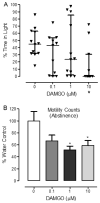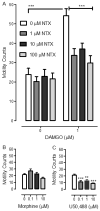Mu Opioid Receptor Agonist DAMGO Produces Place Conditioning, Abstinence-induced Withdrawal, and Naltrexone-Dependent Locomotor Activation in Planarians
- PMID: 29958944
- PMCID: PMC6086122
- DOI: 10.1016/j.neuroscience.2018.06.029
Mu Opioid Receptor Agonist DAMGO Produces Place Conditioning, Abstinence-induced Withdrawal, and Naltrexone-Dependent Locomotor Activation in Planarians
Abstract
Unlike the behavioral effects planarians display when exposed to cocaine, amphetamines, cathinones, ethanol and sucrose, effects of opioid receptor agonists, especially mu opioid receptor agonists, are poorly defined in these flatworms. Here, we tested the hypothesis that planarians exposed to a selective mu opioid receptor agonist, DAMGO (0.1, 1, 10 µM), would display a triad of opioid-like effects (place conditioning, abstinence-induced withdrawal, and motility changes). DAMGO was selected versus morphine because of its greater mu opioid receptor selectivity. In place conditioning and abstinence experiments, the planarian light/dark test (PLDT) was utilized (i.e., planarians are placed into a petri dish containing water that is split into light and dark compartments and time spent in the compartments is determined). Planarians conditioned with DAMGO (1 µM) spent more time on the drug-paired side compared to water controls. In abstinence experiments, planarians exposed to DAMGO for 30 min were removed and then placed into water, where light avoidance (e.g. defensive responding) and depressant-like effects (i.e., decreased motility) were quantified. Compared to water controls, DAMGO-withdrawn planarians spent less time in the light (10 µM) and displayed decreased motility (1, 10 µM). Acute DAMGO exposure (1 µM) produced hypermotility that was antagonized by naltrexone (1, 10, 100 µM). In contrast, acute exposure to the kappa opioid receptor agonist U50,488H (0.1, 1, 10 µM) resulted in decreased motility. Our results show that a mu opioid agonist produces mammalian-like behavioral responses in planarians that may be related to addiction and suggest opioid-like behavioral effects are conserved in invertebrates.
Keywords: Addiction; DAMGO; Mu opioid; Place preference; Planarians; Withdrawal.
Copyright © 2018 IBRO. Published by Elsevier Ltd. All rights reserved.
Figures



Similar articles
-
Chronic exposure to mu-opioid agonists produces constitutive activation of mu-opioid receptors in direct proportion to the efficacy of the agonist used for pretreatment.Mol Pharmacol. 2001 Jul;60(1):53-62. doi: 10.1124/mol.60.1.53. Mol Pharmacol. 2001. PMID: 11408600
-
The role of nitric oxide in the development of opioid withdrawal induced by naloxone after acute treatment with mu- and kappa-opioid receptor agonists.Eur J Pharmacol. 1998 Oct 23;359(2-3):127-31. doi: 10.1016/s0014-2999(98)00684-0. Eur J Pharmacol. 1998. PMID: 9832382
-
Pharmacological Characterization of Dezocine, a Potent Analgesic Acting as a κ Partial Agonist and μ Partial Agonist.Sci Rep. 2018 Sep 20;8(1):14087. doi: 10.1038/s41598-018-32568-y. Sci Rep. 2018. PMID: 30237513 Free PMC article.
-
Blockade of mu-opioid receptor-mediated G-protein activation and antinociception by TRK-820 in mice.Eur J Pharmacol. 2003 Feb 7;461(1):35-9. doi: 10.1016/s0014-2999(03)01299-8. Eur J Pharmacol. 2003. PMID: 12568913
-
Prenatal opioid exposure and vulnerability to future substance use disorders in offspring.Exp Neurol. 2021 May;339:113621. doi: 10.1016/j.expneurol.2021.113621. Epub 2021 Jan 29. Exp Neurol. 2021. PMID: 33516730 Free PMC article. Review.
Cited by
-
Energy drink produces aversive effects in planarians.Physiol Behav. 2022 Oct 15;255:113933. doi: 10.1016/j.physbeh.2022.113933. Epub 2022 Jul 26. Physiol Behav. 2022. PMID: 35905805 Free PMC article.
-
Planarian nociception: Lessons from a scrunching flatworm.Front Mol Neurosci. 2022 Jul 26;15:935918. doi: 10.3389/fnmol.2022.935918. eCollection 2022. Front Mol Neurosci. 2022. PMID: 35959107 Free PMC article. Review.
-
Nonhuman animal models of substance use disorders: Translational value and utility to basic science.Drug Alcohol Depend. 2020 Jan 1;206:107733. doi: 10.1016/j.drugalcdep.2019.107733. Epub 2019 Nov 21. Drug Alcohol Depend. 2020. PMID: 31790978 Free PMC article. Review.
-
Predator odor produces anxiety-like behavioral phenotype in planarians that is counteracted by fluoxetine.Physiol Behav. 2019 Jul 1;206:181-184. doi: 10.1016/j.physbeh.2019.04.003. Epub 2019 Apr 2. Physiol Behav. 2019. PMID: 30951749 Free PMC article.
-
Kratom pharmacology: Clues from planarians exposed to mitragynine.Physiol Behav. 2021 Oct 1;239:113499. doi: 10.1016/j.physbeh.2021.113499. Epub 2021 Jun 17. Physiol Behav. 2021. PMID: 34146575 Free PMC article.
References
-
- Anraku T, Ikegaya Y, Matsuki N, Nishiyama N. Withdrawal from chronic morphine administration causes prolonged enhancement of immobility in rat forced swimming test. Psychopharmacology (Berl) 2001;157:217–220. - PubMed
-
- Bals-Kubik R, Shippenberg TS, Herz A. Involvement of central mu and delta opioid receptors in mediating the reinforcing effects of beta-endorphin in the rat. Eur J Pharmacol. 1990;175:63–69. - PubMed
-
- Bourin M, Hascoët M. The mouse light/dark box test. Eur J Pharmacol. 2003;463:55–65. - PubMed
-
- Brady LS, Holtzman SG. Locomotor activity in morphine-dependent and post-dependent rats. Pharmacol Biochem Behav. 1981;14:361–370. - PubMed
-
- Buttarelli FR, Pontieri FE, Margotta V, Palladini G. Acetylcholine/dopamine interaction in planaria. Comp Biochem Physiol C Toxicol Pharmacol. 2000;125:225–231. - PubMed
Publication types
MeSH terms
Substances
Grants and funding
LinkOut - more resources
Full Text Sources
Other Literature Sources
Research Materials

